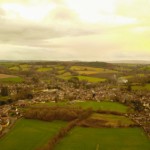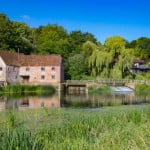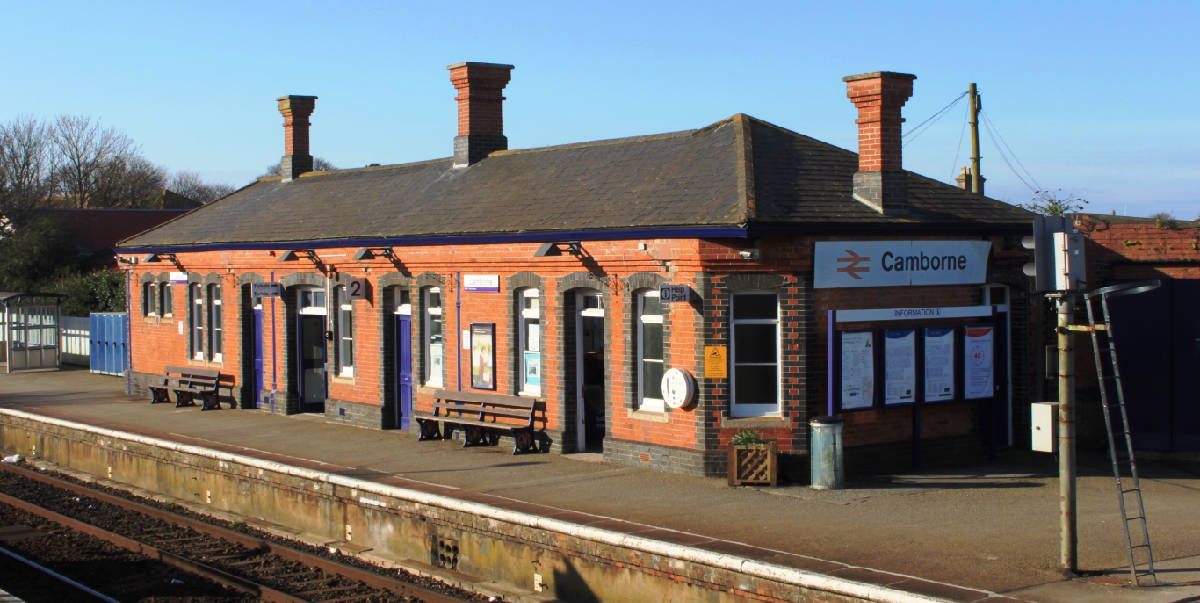
Camborne in Brief
Camborne is a busy market town in the west of Cornwall, southwest England. It’s located just 3 miles southwest of Redruth and 12 miles west of Truro. Camborne is perhaps best known for once being a major centre of Cornwall’s thriving tin and copper industries of the late 18th and early 19th centuries.
Camborne – A Fleeting History
Archaeological ruins unearthed at Magor Farm, Illogan, near Camborne, suggest it was once the site of a Roman villa. It is the only one found in Cornwall to date. However, the first written reference to Camborne didn’t occur until 1181. The modern-day name can be traced back to its original Cornish name ‘Kammbronn’, meaning ‘crooked hill’. The word ‘kamm’ meaning crooked, is similar to ‘cam’ which means the same in both Welsh and Gaelic.
An inscribed altar stone housed in the Church of St Martin and St Meriadoc is dated to circa the 10th century. The Cornish 6th-century St Meriadoc became the patron saint of Camborne. He also gave rise to the 19th-century nickname of Mera-jacks, Merry-geeks or Merrasicks for those emanating from Camborne.
Local records show that small-scale exploitation of shallow mines began in the 15th century. By the late Middle Ages, there were several manors outwith Camborne, which led to the development of hamlets. The 16th century saw drift mining become the norm. By 1708, Camborne held a charter to hold a weekly market and 3 annual fairs, a sign of increasing local wealth and population growth.
By 1720, the working of Camborne’s famed Dolcoath Copper Mine was underway. It was to become the largest and deepest mine in Cornwall and known as ‘The Queen of Cornish Mines’. By the middle of the 18th century, the Camborne area was producing around 70% of the world’s copper. By the end of the century, Camborne had become a major centre of the Cornish tin and copper mining industry, with the great influx of miners rapidly transforming the village into a town.
Engineering In Camborne
In 1801, the country’s first national census recorded the population of the parish of Camborne as 4,811. In the same year, Holman’s set up a small foundry and family engineering business in the town, which was to become Cornwall’s largest manufacturer of industrial equipment. Also in 1801, famed local son, Richard Trevithick gave his ‘Puffing Devil’ road locomotive its maiden run through the streets of the town. In 1806, Camborne saw the founding of its first Methodist chapel, initiating the corresponding development of its local Methodist community.
In 1834, Camborne’s first gasworks was established. Also, in 1834, work on a railway from Camborne to Hayle and Portreath began. Known as the Hayle Railway, it was completed in 1837. Initially, it was utilised by the mining industry but from 1843 onwards, it also began to carry passengers. By 1841, the town’s population had more than doubled from that of 1801, standing at 10,061.
By this time, the parish had more than 75 smiths and more than two-thirds of the working population were employed in the mining industry. In 1851, the first School of Mining was established in the town. By 1871, the population of Camborne parish reached an apex, rising to 14,929.
Tin On The Decline
However, events on the other side of the world were about to affect Cornwall. In 1872, large deposits of tin were discovered in the Australian states of Queensland, New South Wales and Tasmania. Additional competition from Malaya and Bolivia was the final nail in the coffin for Cornwall’s tin industry. In the first six months of 1875 alone, over 10,000 miners left Cornwall to find work overseas. Only the profitable Dolcoath Mine saved Camborne’s miners’ livelihoods, but in 1921, it too was forced to close.
In 1902, the Camborne and Redruth Tramways company set up Cornwall’s only ever tram service. The electric freight and passenger trams provided regular services between the two towns, with the company enjoying early success. However, in 1926, the Cornish Motor Transport Company began operating a ‘fast’ bus service between Redruth and Camborne, which reduced the patronage of the passenger tram service. The tram company began to lose money and ceased its passenger operation in 1927, although the freight service managed to survive until 1934, before closing.
The two World War years saw a brief revival of Cornwall’s tin industry. This was because of increased demand for Cornish tin and the fact that cheaper import supply lines were disrupted. Holman’s also played their part in World War II manufacturing the Polish-designed 20mm Polsten gun and for a while the famed Sten gun. The company also produced the Holman Projector for the Royal Navy, an anti-aircraft weapon primarily used between early 1940 and late 1941.
Modern Camborne
In 1968, Camborne’s renowned Holman Bros, which at its peak had employed 3,500 locally, merged with Broomwade to form CompAir Holman. Over the preceding decades, the ownership of the group proceeded to pass through various hands, until 2003, when the inevitable finally came to its conclusion. In May 2003, the company announced that due to increasing international competition it was to close its Camborne operation within 3 months with the loss of 184 local jobs.
In 1998, the last working tin mine in the whole of Europe, South Crofty at Pool, near Camborne was closed. Some of the tin produced from South Crofty was purchased by a local business and is used to make specialised tin jewellery branded under the ‘South Crofty Collection’ banner. Tin mined at South Crofty was also used to make the bronze medals awarded at the 2012 London Olympics.
The Camborne-Redruth urban and the surrounding areas form the largest conurbation in Cornwall, with a population of more than 55,000. The population of Camborne itself was recorded as 20,845 at the last UK National Census in 2011.
Employment
Today, like much of the rest of Cornwall, Camborne suffers from relatively high unemployment, with few well-paying job opportunities. The majority of people in Camborne are employed in the service sector, including tourism. However, one bright spot on the horizon (2020) is that advancement in mining techniques has led to the possibility that South Crofty may be reopened for the mining of copper and lithium. Obviously, this has great potential to create local well-paid jobs and attract much needed inward investment to the area.
Trevithick Day
Since 1984, one of the most anticipated days in the Camborne calendar is Trevithick Day. The free one-day festival celebrates the town’s industrial past and the life of the engineer, inventor, and local hero Richard Trevithick. The celebration usually takes place on the last Saturday of April. It’s a typical carnival atmosphere when the town’s main streets are closed to traffic and steam engines, food stalls, bands and entertainers take over. The day can attract up to 30,000 visitors.
Getting There!
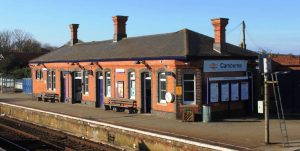
Geof Sheppard, CC BY-SA 4.0 via Wikimedia Commons
Camborne is a fairly remote location but it has rail, road, and air links with the rest of the country. It can take a while depending on the method you use but trust us it’s worth the journey.
By Car
Despite its relatively remote location, getting to Camborne by road is relatively easy. Just follow the M5 motorway towards Exeter until you reach the A30. Stay on the A30 all the way to the Talvaddon Interchange at the start of the Camborne-Pool-Redruth Bypass. From there turn on to the A3047, from which Camborne is a short drive.
By Bus
National Express runs 4 buses daily from London Victoria to Camborne with a journey time of around 8.5 hours. From the North and the Midlands, you may need to change buses at Bristol.
By Train
The direct train services from London Paddington, South Wales and Scotland to Penzance, stop at Camborne. There’s also a sleeper service from London Paddington.
By Air
The nearest airport to Camborne is Newquay, to which regular services from London Gatwick and Manchester fly. From Newquay airport, expect it to take about 35 minutes by taxi or car for the 25-mile drive to Camborne. Alternatively, take the bus from the airport to Truro, and from there, the train to Camborne.
Sport In Camborne
Camborne RFC
Camborne RFC is one of the oldest and most renowned clubs in Cornwall. The first XV currently plays in the South West Premier League (2020), level five of the English rugby union system. Established in 1878, the distinctive club colours give rise to their nickname ‘The Cherry and Whites’. They play their home games at the Recreation Ground, which has a capacity of 7,000. The ground is also sometimes used as a venue for county fixtures.
A Famed Son
Richard Trevithick was born on 13 April 1771 in the hamlet of Tregajorran, near Camborne. The son of a mine works supervisor, Trevithick took a great interest in both mining and engineering from an early age. Although he performed poorly in school, he went on to become a pioneer of the steam-power industry, developing the first high-pressure steam engine.
In 1801, Trevithick completed the final build of the first working full-size steam road locomotive at a site near Fore Street in Camborne. Named by Trevithick as ‘Puffing Devil’, he took it to the streets of Camborne on Christmas Eve. It successfully carried six passengers from Fore Street, up Camborne Hill, to the nearby village of Beacon. This is widely recognised as the first steam-powered journey ever undertaken and inspired the popular Cornish folk song “Camborne Hill”.
Trevithick also went on to build the first full-scale steam railway locomotive, which in February 1804, hauled a train along the tramway at the Penydarren Ironworks in Merthyr Tydfil. Later, he pioneered the use of steam power in deep-shaft mining, which changed the face of the industry across the world. He then went to work as a mining consultant and somewhat of an explorer in South and Central America.
However, fate would prove unkind to Trevithick. He arrived back in England at Falmouth in October 1827, with little more than the clothes he stood up in. In April 1833, Trevithick found himself working on a project in Dartford, where he caught pneumonia. He died there a week later, on 22 April, aged 62. He died pennilessly and was buried in an unmarked grave at the town’s St Edmund’s Burial Ground.
Did you know?
- In the 2011 UK census, 30 people from Camborne stated that Cornish was the main language they used at home.
- Holman’s Bros. engineering company was commissioned to make the ‘Sten’ sub-machine gun for a stint during WW2.
- Camborne was a terminus station for Cornwall’s one and only tram service that operated from 1902 to 1934 (see above).
- The town is situated within the UNESCO World Heritage Site that recognises Cornwall’s unique mining legacy.
- Camborne is twinned with Santez-Anna-Wened in Brittany, France, and Pachuca, Hidalgo, Mexico.
Things to do and see
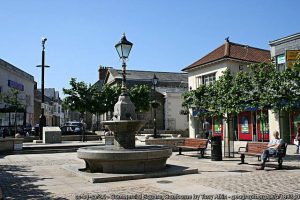
Commercial Square
A few recommendations for things to see and do around Camborne are;
- King Edward Mine Museum – is a mine that dating back to the 19th century where most of the equipment has been restored to working order. The Grade II listed buildings form part of the World Heritage Area of Cornwall. The Museum is only open during the summer months.
- Tehidy Country Park – once owned by the powerful Basset family is now in the hands of Cornwall County Council. It has some 9 miles (15km) of paths, 250 acres of woodlands and lakes, and lots of wildlife. There’s also a café and a picnic area. There are five main access points with car parks at South Drive and North Cliff.
- The Great Flat Lode Trail – is a challenging 7-mile walk/cycling route/bridleway just outside Camborne that passes through the heartlands of its mining heritage. Parking is at South Wheal Frances car park.
- Locked-in Escape Rooms – is an organised event and fun activity where you and your group race against time to find clues and solve puzzles.
- Heartlands – is an all-year-round and all-weather entertainment centre for all. The 7.5-hectare site has, amongst other attractions, state-of-the-art exhibitions, climb-on sculptures, diverse gardens, a kid’s giant adventure playscape area, art and craft studios and a unique café housed in a carpenter’s old workshop.
- East Pool Mine – is a mining museum with original above-ground buildings that have been restored and utilised to house exhibition material. As well as short films and photographs, there are also models and hands-on activities to explain how the mine operated. There’s also free parking, tea and coffee available, and a small shop.
Things Nearby
- The Great Flat Lode Trail – is a challenging 7-mile walk/cycling route/bridleway just outside Camborne that passes through the heartlands of its mining heritage. Parking is at South Wheal Frances car park.

Image: Grinder1977/Shutterstock.com
- Carn Brea – is a wide-open area of outstanding countryside that overlooks both Camborne and Redruth that reaches 738 ft above sea level. Close to the peak, there’s a 90 ft granite obelisk built in 1836 and dedicated to local mining entrepreneur, Sir Francis Basset (1757 – 1835). There’s also an 18th-century folly, Carn Brea Castle, built by the Bassett family on the site of an old chapel, which is now a restaurant.
- Visit Pendarves Wood Nature Reserve which is located around two miles out of the town. If you love strolling through broad-leafed woodland then you are in for a treat. there is plenty of wildlife to see and go at the right time of year and its carpeted with Bluebells. The only thing to bear in mind is that dogs are not allowed.

Image: Paul Nash/Shutterstock.com
Where to stay?
If you’re looking for somewhere to stay in Camborne then accommodation is fairly limited, especially if you are looking for a top-end room. Redruth and Portreath are only 3 or so miles away which obviously gives more options. Hayle, St Ives and Truro 6-8 miles away, offer yet more choice. Prices are pretty similar throughout the area. A broad indication of prices for 2 adults sharing for the most common types of accommodation in the general area are:
B & B/Guesthouses: £60 – £90
Standard Hotels/Inns £90 – £130
3/4/5 Star Hotels £130 – £250
Moving to Camborne?
Thinking of moving to Camborne? The average property price in the town for June 2020 stood at approximately £191,700. This represents a fall of about 6.4 % on the average price paid in the last 12 months. In terms of property types, flats were selling for an average of £122,100 and terraced houses for £152,000.
So there you have it our Five Minute Overview of Cranborne. Before you go why not try some of our other quizzes or have a look at some of our other location guides. better still why not join our growing community it’s free and could be very rewarding going forward.
Why not take the Camborne quiz?
Quiz Maker – powered by Riddle

